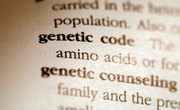
Mendelian genetics and modern genetics are really just parts of the same thing. Gregor Mendel formed the basis of modern genetics. Later scientists built on his ideas and laws, elaborating on them. Nothing in modern genetics disagrees with Mendel's interpretation of genetics, but it has found cases where genetics is more complicated than the version he uncovered.
Mendelian Genetics
Gregor Mendel performed his famous experiments on pea plants. By observing the outcome of crossing different pea plants, Mendel was able to figure out that both parents contributed an allele to their young. Alleles are the varieties an inherited trait may have (so "straight-leafed" and "curly-leafed" might be two alleles of the "leaf-shape" characteristic). Mendel figured out that some alleles -- called dominant alleles -- will mask the presence of other alleles -- called recessive alleles. Using probability and an understanding of these laws of genetics, Mendel could predict the outcome of crossing different pea plants together. As the understanding of genetics later evolved, it became clear that alleles were usually different versions of genes.
Polygenic Traits
In some cases, the picture is more complicated than basic Mendelian genetics. For example, sometimes multiple alleles interact with each other. Mendel's methods can work just fine for a handful of alleles. But sometimes, many genes interact to produce a trait. Traits influenced by multiple genes are called "polygenic traits." Height is often used as an example of a polygenic trait, since it does not appear to follow basic Mendelian patterns. However, each individual gene that contributes to height does follow these patterns. It is only because many different genes contribute that height appears to contradict Mendelian genetics.
Sex-Linked Traits
Sex-linked traits are a special area of Mendelian genetics. In humans, sex is determined by two paired chromosomes called sex chromosomes. Females have two X-shaped sex chromosomes, with the same genes but often different alleles. Males have one X-chromosome, and one shaped like a "Y." The Y-chromosome does not have most of the genes found on the X-chromosome. So in human males, a few traits, like baldness and the most common form of colorblindness, follow special patterns. For example, males are more likely to develop colorblindness, since they only get one copy of the allele (from the their mother), and the father cannot contribute a copy of the gene. Most sex-linked traits follow normal Mendelian patterns in females.
Chromosomes, Genes and DNA
The big difference between the modern science of genetics and Mendel's basic laws is that modern scientists have a much clearer understanding of the mechanisms behind the patterns Mendel observed. For example, in the 1950s and 1960s several researchers, including such figures as Doctors James Watson and Francis Crick at Cambridge University, decoded the structure of DNA. Scientists now know that genes/alleles are encoded into DNA, which the body arranges into chromosomes when dividing cells. Understanding the underlying mechanisms of genetics has allowed scientists to further build on Mendel's work. Nothing in modern genetics contradicts Mendel's work, it just explains why Mendel's laws work, and explains the few situations when they seem to not apply.
References
- National Genome Research Project: Talking Glossary: Polygenic Trait
- North Dakota State University: Mendelian Genetics: Mendel's First Law of Genetics (Law of Segregation)
- National Institute of Health: History Office: Gregor Mendel: The Father of Modern Genetics
- National Institute of Health: History Office: Identifying DNA
- University of Arizona: The Biology Project: Sex-Linked Inheritance
Photo Credits
Jupiterimages/Photos.com/Getty Images
